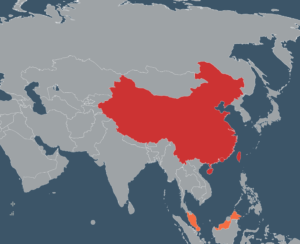汉语
漢語
Language Facts:
Speakers: +1 Billion
Family: Sino-Tibetan
Status: Official in China, Taiwan; Recognized in Malaysia
Family: Sino-Tibetan
Status: Official in China, Taiwan; Recognized in Malaysia
Script: Simplified Chinese Characters (mainland China) , Traditional Chinse Characters (Taiwan, Hong Kong)
- Chinese learners will have to choose between learning primarily Simplified Characters or Traditional Characters. This might depend on an area of interest, but all things equal Simplified will be a little easier to learn. While it’s true that learning the characters is quite the undertaking, it’s not quite as complicated as at first glance. But to become proficient you will have to learn thousands of characters.
- Pinyin is a standardized romanization of the Chinese language. It’s important at the beginning to learn some fundamentals with pinyin, as they will be the base for typing and pronunciation/tone.
- There are 4 tones , plus a neutral tone. Getting comfortable with the tones is a big challenge for someone to learn Chinese, especially if they don’t speak/have studied a total language before, like Thai or Cantonese.
- Word order is Subject-Verb-Object, like English.
- Mandarin is a very analytic language, or to say that words don’t change based on grammatical function and instead syntax and participles are used to convey grammatical information. Because of this, some aspects of Mandarin grammar will be surprisingly simple to learn.
- Verb tense doesn’t exist in a way a Western language speaker would be used to. There are participles to indicate aspects of verbs, like completed actions or progressive actions, but sometimes the tense in which an action takes place is left to context.
- A challenging part of vocabulary acquisition will be measure words, that pair to different categories or types of nouns. These measure words are mandatory when indicating any amount of a town (think: two bottles of water, one pair of socks)

Learn Mandarin:
Books:
Chineasy – a great place to start with learning Chinese characters. They break down the root meaning of the core components of characters (radicals) in a fun and interesting way. After this book you will be able to make more meaningful connections when learning characters
Learn Mandarin Chinese: For Beginners – good beginner introduction to the language.
Online:
Mandarin Bean – an absolutely fantastic website with hundreds of stories for every level. Includes Pinyin, hover over translations, and both simplified and traditional characters. An invaluable website to learn and read Mandarin Chinese.
Pimsleur – classic audio course. Great for beginners for a focus on hearing and speaking the tones of Mandarin and basic conversations.
HelloChinese – Duolingo style app, but much better suited specifically for Mandarin. Includes speaking and stories. This will be the best app to get started learning Mandarin.